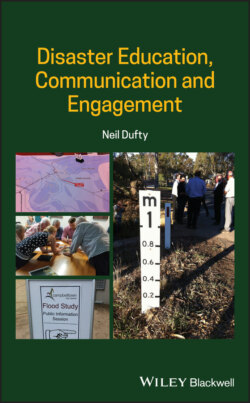Disaster Education, Communication and Engagement

Реклама. ООО «ЛитРес», ИНН: 7719571260.
Оглавление
Neil Dufty. Disaster Education, Communication and Engagement
Table of Contents
List of Tables
List of Illustrations
Guide
Pages
Disaster Education, Communication and Engagement
Acknowledgements
1 Disasters and Learning
1.1 Hazard
1.2 Disaster
1.3 Disasters Are Socially Constructed
1.4 Disasters and Communities
1.5 Learning
References
2 Disaster ECE. 2.1 Disaster Education. 2.1.1 Defining Disaster Education
2.1.2 Modes of Disaster Education
2.1.3 Learning Relationships
2.2 Disaster Communication
2.2.1 Risk Communication. 2.2.1.1 Risk
2.2.1.2 Risk Perception
2.2.1.3 Trust
2.2.1.4 Communicating Risk
2.2.2 Crisis Communication
2.2.2.1 Early Warning
2.2.2.2 Response
2.2.2.3 Recovery
2.2.2.4 Between Agencies
2.3 Engagement
2.3.1 Public Participation Spectrum
2.3.2 Crowdsourcing
2.3.3 Citizen Science
2.3.4 Community Participatory Disaster Risk Assessment
2.3.5 Volunteered Geographic Information
2.4 Disaster ECE
References
3 ECE Across the Disaster Management Cycle. 3.1 ‘The Disaster Management Cycle’
3.2 Mitigation
3.2.1 Disaster Risk Analysis
3.2.2 Risk Awareness
3.2.3 Mitigation Options
3.3 Preparedness
3.3.1 Preparedness Guides
3.3.2 Emergency Plans
3.3.3 Campaigns
3.3.4 Learning Methods
3.4 Early Warning
3.5 Response
3.5.1 News Media
3.5.2 Social Media
3.6 Recovery
3.7 Lessons Learned
3.8 Reconstruction
References
4 The Importance and Usefulness of Disaster ECE
4.1 Inputs
4.2 Activities
4.3 Outputs
4.4 Short-Term Impacts
4.5 Intermediate Impacts
4.6 Outcomes
References
5 Exploring Relevant Research Fields
5.1 Disaster Resilience. 5.1.1 The Resilience Concept
5.1.2 Disaster ECE and Resilience
5.2 Disaster Psychology. 5.2.1 Risk Awareness and Perception
5.2.2 Previous Experience and Local Knowledge
5.2.3 Preparedness
5.2.3.1 The Protection Motivation Theory (PMT)
5.2.3.2 Protective Action Decision Model (PADM)
5.2.3.3 Socio-Cognitive Preparedness Model
5.2.4 Response
5.2.5 Recovery
5.3 Disaster Sociology
5.3.1 Vulnerability
5.3.2 Social Capital
5.4 Learning Theory
5.4.1 Behavioural Learning
5.4.2 Cognitive Learning
5.4.3 Affective Learning
5.4.4 Social Learning
References
6 Designing Effective Disaster ECE Plans and Programmes
6.1 Lifelong Learning
6.2 Localisation and Learner Needs
6.3 A Framework for Tailoring Disaster ECE
6.3.1 Principles of Effective Disaster Education
6.3.2 ‘Palettes’ of Potential Content and Methods
6.3.3 ‘Filters’ to Choose Appropriate Local Disaster ECE Content and Methods
References
7 Disaster ECE Principles
References
8 Disaster ECE Content
8.1 Across the Disaster Management Cycle
8.1.1 Mitigation
8.1.2 Preparedness
8.1.3 Early Warning
8.1.4 Response
8.1.5 Recovery
8.1.6 Lessons Learned
8.1.7 Reconstruction
8.2 Disaster Resilience
8.3 Climate Change
8.3.1 Climate Change and Disaster Risk Reduction
8.3.2 ‘Global Warming’ vs ‘Climate Change’
8.3.3 Support for Climate Change
8.3.4 Implications for Disaster ECE
8.4 Sustainability
References
9 Disaster ECE Methods
9.1 A Typology of Disaster ECE Methods
9.2 Information
9.2.1 Maps
9.2.2 Frequently Asked Questions (FAQs)
9.2.3 Warning Sirens
9.2.4 Emergency Alert Messages
9.3 Interactions
9.3.1 Social Media
9.3.2 Apps
9.3.3 Games
9.3.4 Virtual Reality
9.3.5 Scenario Planning
9.3.6 People–People Interactions
9.4 Skills and Capabilities
9.4.1 Drills
9.4.2 Exercises
9.4.3 Oral, Visual, and Written Histories
9.4.4 Communities of Practice
9.4.5 Awards
9.4.6 Simulations
9.4.7 Staff Ride
9.4.8 Volunteering
9.5 Creative Expression
9.5.1 Art
9.5.2 Writing
9.5.3 Movies
9.5.4 Puppetry
9.5.5 Memorials
9.6 Integrating Methods
References
10 Understanding Communities and Their Risks
10.1 Understanding the Local Community
10.1.1 Population Surveys
10.1.2 Questionnaires
10.1.3 Social Network Analysis
10.1.4 Local Knowledge
10.2 Local Disaster Risks
10.3 Risk Reduction Measures
10.4 Emergency Management
10.5 Building Resilience
References
11 Learners
11.1 Youth
11.1.1 Vulnerability
11.1.2 Youth and DRR
11.1.3 Disaster ECE in Schools
11.1.4 Curriculum-Based Learning
11.1.5 Non-curricula Learning
11.2 Other Vulnerable People
11.2.1 Women and Girls
11.2.2 People with Disabilities
11.2.3 Older People
11.3 Businesses
11.3.1 Vulnerabilities
11.3.2 Mitigation
11.3.3 Preparedness
11.3.4 Recovery and Resilience
11.4 Animal Guardians
11.5 Tourists
11.6 Archetypes
References
12 Disaster ECE Programmes and Plans. 12.1 Tailoring Disaster ECE
12.2 Disaster ECE Plans
12.3 Disaster ECE Programmes
12.4 Evaluation
12.5 Participation
References
Index
WILEY END USER LICENSE AGREEMENT
Отрывок из книги
Neil Dufty
Molino Stewart Pty Ltd
.....
Early warning is the bridge between risk and crisis communication. ‘Early warning is not only the production of technically accurate warnings but also a system that requires an understanding of risk and a link between producers and consumers of warning information, with the ultimate goal of triggering action to prevent or mitigate a disaster’ (International Federation of Red Cross and Red Crescent Societies 2009).
Clear, timely, and accurate warning information should be communicated to at-risk communities. The International Federation of Red Cross and Red Crescent Societies (2014a) states that ‘the outputs of an early warning system must recognise the diversity of the audience and be appropriate to that audience. Outputs should be contextualised, granular and specific to potentially impacted localities. They should include clear explanations of degree or severity, of trend, of timing, and of the confidence associated with the prediction. The choice of the language and the medium of the communication should be appropriate to the audience, as should the level of technical complexity.’
.....